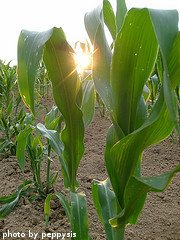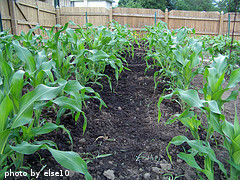Fertilizing and Watering Corn
Corn plants typically need about 1.5 inches of rain per week to thrive. You need to be watering corn plants regularly if you don't get any rain. Sweet corn also does well with a couple of doses of fertilizer throughout the growing season.
The root systems of the plants absorb moisture in the soil. The idea is that there should be some nutrients in the soil that will also be absorbed. So a combination of irrigation and fertilizing is needed for good yields of sweet corn.
Watering Corn

Try watering corn plants in the early morning hours. That way, the afternoon sun will evaporate any extra water that isn't absorbed into the soil. It will also eliminate water from sitting on the ears of corn, preventing the development of mildew.
To determine if your sweet corn plants need water, use your fingers and dig down about 4 inches into the soil next to your plants. Grab a handful of dirt and squeeze it in your palm. You want the soil to be moist enough that it holds together for a few seconds before falling apart. If the soil is wet and soggy and doesn't fall apart at all when squeezed, let it dry out for a day or two and check again. If the soil is dry and crumbly and doesn't hold together at all when squeezed, you need to give your sweet corn plants some water.
It's better to give your corn crop one long soak per week if no rain falls, rather than several short watering sessions. The plants derive most of their water and nutrients through the root system. If too little water is applied per session, it won't reach the roots and your efforts will be wasted. Remember to take into account any rain that falls. Too much watering can lead to soggy soil. The plants will tend to fail if they sit in soggy soil for extended periods of time. However, they will also fail if they don't get nearly enough water.
In our own garden, we use a cheap, overhead lawn sprinkler to water our sweet corn plants. Because there aren't too many fungal problems with sweet corn, we aren't worried about the tops of the plants getting wet. If we don't get any rain for a week or so and our soil is fairly dry, we'll usually run the sprinkler for about 30 minutes or so. This is usually enough to give the plants what they need and keep the soil moist at the root level.
In order to retain soil moisture and temperature, a layer of mulch can be applied. Grass clippings, hay or chopped up leaves are usually the most readily available mulch options. The mulch can be applied in multiple layers. If you begin mulching early on, be sure not to cover up the seedlings. Additional layers of mulch can be added as the plants grow. It's not uncommon to have a 3-6 inch layer of mulch by the time the ears begin maturing. Proper mulching will also cut down on weed growth. All of this mulch can also be tilled into the soil at the end of the growing season. It will break down over time and add nutrients to your garden plot.
Fertilizing Sweet Corn
After the seedlings reach 12 inches tall, a 10-10-10 fertilizer can be applied to promote growth. Most granular fertilizers are applied at a rate of 1 1/2 pounds per 100 square feet. Consult the fertilizer package for application instructions. Try to avoid letting the granules touch the plants themselves, as this may burn your plants. Instead, scatter the granules on the outside edges of the rows. Water shortly after applying the fertilizer. Watering corn after applying the fertilizer allows the granules to enter the soil where the roots can absorb
it.
You may also choose to use a water soluble type fertilizer. In this case, it's easiest to use a hose end sprayer and apply the fertilizer according to the manufacturer's instructions.
In our own garden, we add a balanced granular fertilizer to the soil before we even plant our corn seeds. We till up the plot and scatter the fertilizer at a rate of about 1 pint per 100 square feet of garden space. We also scatter pulverized lime over the area as our soil is a bit acidic and lacking calcium. We till in the fertilizer and lime and then water it in well. 5-7 days later, we till one last time, build our raised rows and plant our corn seeds. We then give our sweet corn crop one more dose of fertilizer when the plants reach a foot tall. We add the granular fertilizer as a side dressing along the edge of each row.
Now that you know about fertilizing and watering corn, it's time to think about harvesting your crop.

Click here to move from our Watering Corn page to the Harvesting Corn page
Click here for corn recipe ideas
Click here to return to the Growing Sweet Corn main page
Click here to return to our Home page